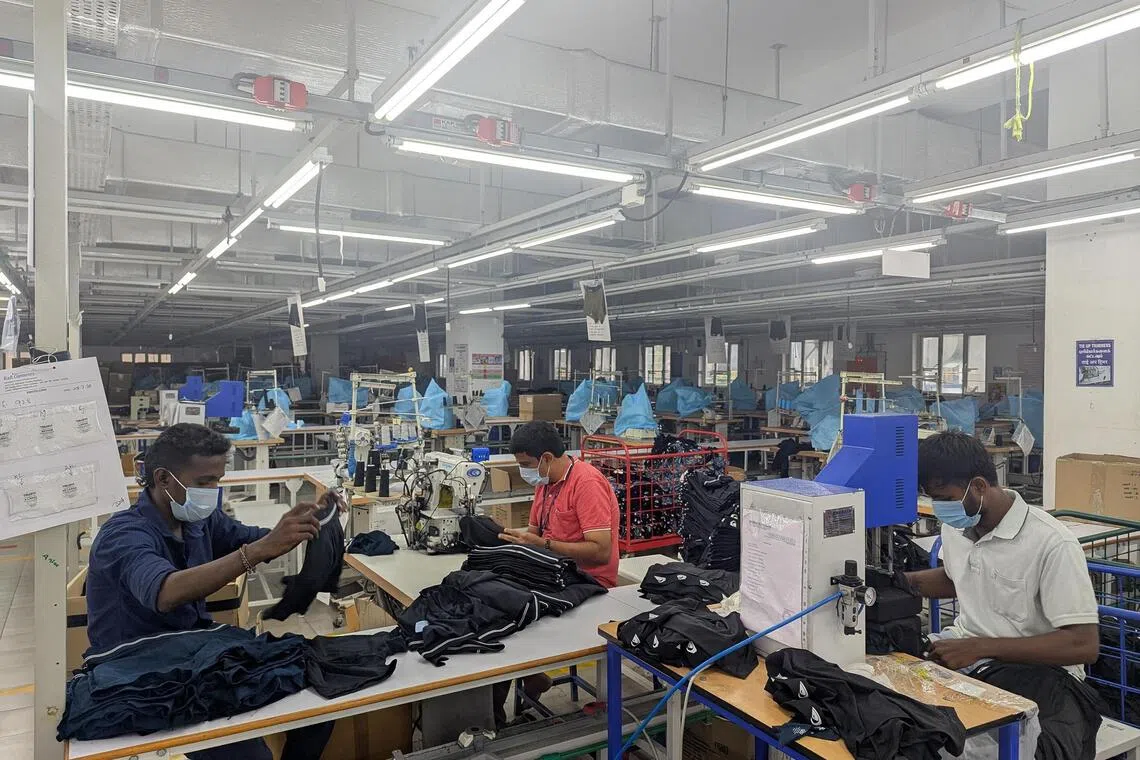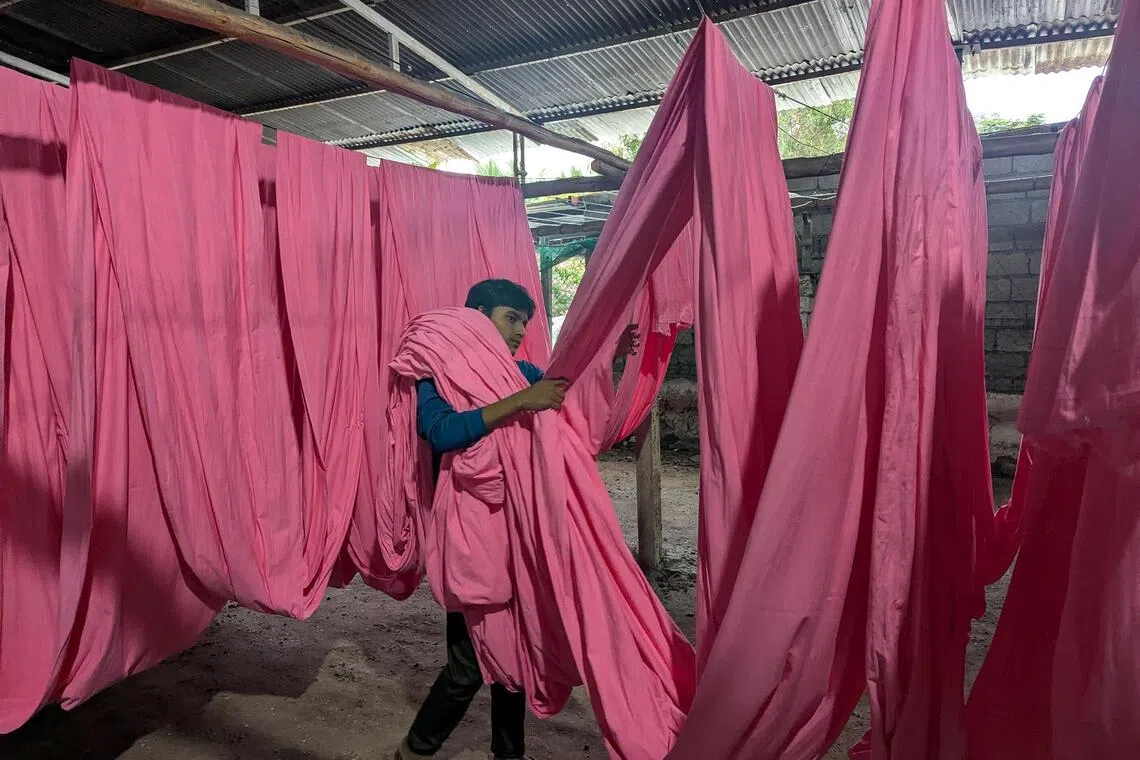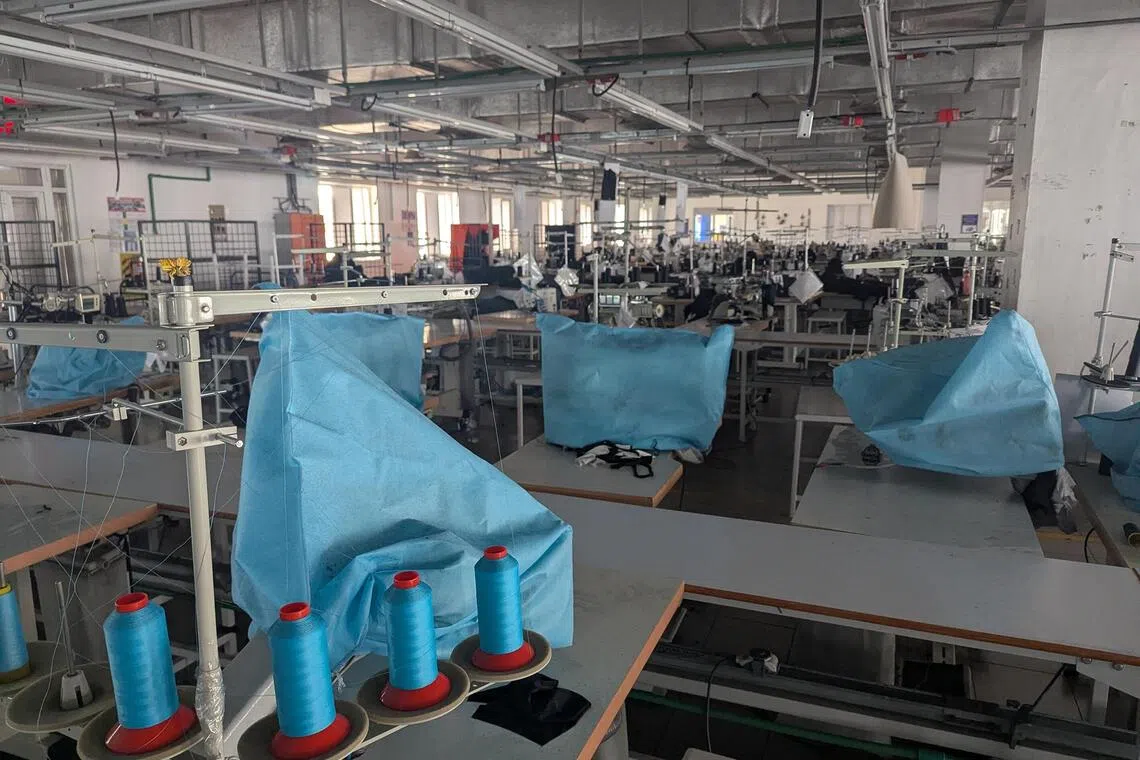Hanging by a thread: 50% US tariffs put Indian textile exporters in survival mode
Sign up now: Get insights on Asia's fast-moving developments

The Tiruppur Exporters’ Association estimated the hub has been hit by a loss of 12 billion rupees since the US tariff hike was announced.
ST PHOTO: ROHINI MOHAN
Follow topic:
- US tariffs of 50% on Indian goods, including a 25% penalty for buying Russian oil, significantly impact Tiruppur's textile exports, causing order cancellations and financial strain.
- Tiruppur businesses are cutting costs, seeking new markets in Europe and Africa, and some are considering setting up factories in countries with lower tariffs.
- While awaiting government support and US trade negotiations, industry experts stress the need for innovation, diversification, and modernising textile production.
AI generated
TIRUPPUR - Indian textile businessman R.K. Siva Subramaniam is used to what he calls cycles of tension. But he is at a loss about how to emerge from the crisis triggered by US President Donald Trump’s 50 per cent tariff on Indian goods.
The US is the largest export market for India’s US$179 billion (S$234 billion) textile and apparel industry, whose export earnings in 2024 totalled US$37 billion. But that market is shrinking fast.
“Our Indian government asks us to find new markets to export to instead of the US. Textiles are not vegetables – it’s not easy to just go here, go there. It will take six months to a few years to find importers in other markets, and even then, purchase orders are unlikely to be in American quantities,” said Mr Siva, 50.
Since Aug 27, when Mr Trump imposed a 50 per cent tariff on goods imported from India – including a 25 per cent penalty for buying Russian oil
Tiruppur in Tamil Nadu contributes 68 per cent of India’s knitwear exports, and 35 per cent of Tiruppur’s output goes to the US, with shipments totalling 15 billion rupees (S$221 million) a month.
The Tiruppur textile hub has 2,500 companies and around 20,000 small and medium-sized ancillary units like carton box makers, polybag manufacturers and transporters. About 800,000 people work in the textile trade in Tiruppur – this is about 2 per cent of India’s 45 million-strong textile workforce.
The Tiruppur Exporters’ Association (TEA) estimated the hub has been hit by a loss of 12 billion rupees since the US tariff hike was announced. Tiruppur’s jolt reflects the struggles faced by Indian apparel exporters nationwide.
“When Trump announced the first 25 per cent tariff on July 30, it was only slightly more than the 19 per cent to 20 per cent tariffs our competitors in Bangladesh, Vietnam, Pakistan, Sri Lanka and Myanmar faced. It hit our wafer-thin margins of 5 per cent to 10 per cent, but we exporters and American buyers agreed to share it,” said Mr Kumar Duraisamy, joint secretary of TEA, attributing India’s resilience to being the globe’s second-largest cotton producer after China.
“But after the US imposed the additional 25 per cent on India as penalty (for buying Russian oil) in August, it was like sending a patient to the intensive care unit. No buyer will absorb 50 per cent,” he added.
Mr Siva’s Raft Garments, a family-owned knitwear manufacturer, exports more than half of its cotton underwear and T-shirts to the US – to importers that supply brands like Nautica, New Balance and Skechers. But the orders have since dried up.
“I had orders for a total of two million pieces in April from the US, due this year. After the August tariff, the importers took only 500,000 pieces – that, too, I had to ship at a loss in November, bearing most of the 50 per cent tariff myself. The remaining 1.5 million pieces are on hold and no new orders are coming,” Mr Siva told The Straits Times.
He added that American buyers were asking for discounts that he could not afford.
Exporters entirely dependent on US imports have been hit hard, but others, too, said that after the initial panic, they are now in “survival mode”.
To tide over the overnight shock of the 50 per cent tariffs
These have kept the lights on in factories for now, even though firms are unable to map out long-term production schedules and banks are cautious about extending credit to US-dependent exporters.
While immediate catastrophe has been averted, an undercurrent of impending doom still runs below the surface.
To survive, companies are retrenching workers and competing in a price race to the bottom as they seek the same small pool of non-American buyers, industry insiders said.
Sewing up new markets
A young entrepreneur from Tiruppur who requested anonymity said there is no choice but to “find other shores to survive”.
“Tired of the uncertainty”, the 38-year-old businessman said he was not only making trips to Europe and South Africa to woo customers, but also booking tickets to Bangladesh and Vietnam to assess the possibility of setting up factories in these nations, which face lower US tariffs.
“As long as Trump is there, anything can happen. We need to bet on ourselves, not governments and their on-and-off friendships,” he told ST.

The Tiruppur textile hub has 2,500 companies and around 20,000 small- and medium-sized ancillary units like carton box makers, polybag manufacturers and transporters.
ST PHOTO: ROHINI MOHAN
Others, however, think that finding new markets is easier said than done.
Mr Jeevan Xavier, founder of JLX Studio, which consults on knitwear design for brands like H&M and Target, said he had no orders, but diverting exports is not as promising as it is made out to be: “The US is the only unified market we have. Is there another country that has America’s capacity? Only China, but India doesn’t have much trade for finished products with China.”
The average American household spends around US$2,000 a year on apparel and footwear, and TEA said at least seven of these items are from India, whether they are jackets, flip-flops or jeans. In contrast, the average European household spends around US$890 a year.
Mr Siva noted that a single American importer would place an order for about 500,000 pieces, equal to the combined orders of five companies in Europe, where diverse styles are preferred to large volumes.
To ride out the crisis, companies like Raft Garments have shrunk their operations.
Of the 15 lines of sewing machines at its factory at the Netaji Apparel Park in Tiruppur, only five were in operation when ST visited, with the machines that were not in use covered with blue plastic.
“We are working at a third of our capacity because we don’t have orders to meet. Migrant workers from North India went home for their Deepavali break, and I have not called them back because I have no work for them,” Mr Siva said.
Of 250 employees, only 84 were at work.
Instead of two shifts, the unit now runs only one, to service orders from Europe and the Middle East.
Entrepreneurs across Tiruppur have responded with similar tweaks to operations, while some of the larger companies have reportedly closed a few factory units.

Raft Garments has closed 10 of its 15 lines of sewing machines, covering them with blue plastic.
ST PHOTO: ROHINI MOHAN
Workers sense downturn
The blow to Tiruppur’s workforce has come not through overnight mass layoffs but through a gradual, industry-wide paring down of targets, shifts and contract hiring.
Workers from three manufacturing units of mega exporters in the Netaji Apparel Park told ST that they have not gone in to work in over a month. They mistakenly ascribed the dip in production to “increased goods and services taxes”, which they claimed was what their employers told them, though ST could not confirm it.
Young workers from the north and eastern states of Odisha, Jharkhand, Bihar and Assam account for 70 per cent of the workforce in Tiruppur. ST saw many waiting at the train station to return home.
“I came back after Deepavali and worked for a week, but my employer said there’s no more work. I can’t pay rent here without an income, so our hiring agent told a dozen of us to go home,” said Ms Parvathi, 21, who hails from a tribal family in South Chotanagpur in the northern state of Jharkhand. She gave only one name.
Mr Sampath R., 38, a local who has been a tailor for seven years with an exporter he did not want to name, said he was now working nine hours a day, down from 12 in 2024.
“Piece-rate workers”, as the apparel industry calls the lowest rung of freelance garment workers, are sensing a shift with their lighter workloads.
Such workers are predominantly women and members of the Dalit (formerly untouchable) communities hired by small or medium-sized units. They are paid a rupee or less for every garment they hem, stitch buttons on, or affix zippers to.
Returning home after attaching around 300 ribbons to baby onesies, instead of the previous month’s 1,000, a worker named Mrs Ruby, 30, said her “work pressure is much less, which is a relief for me for the present and a source of worry in the future”.
Waiting for relief
Exporters have asked the Indian government for support to overcome the impact of the tariffs, such as lower debt interest and duty waivers. The Confederation of Indian Textile Industry urged the Reserve Bank of India to add spinning, weaving and processing units to the list of eligible sectors for trade relief measures announced on Nov 14.
In mid-November, the Indian government offered 200 billion rupees in credit support to exporters in sectors affected by the global tariffs, but even as he welcomed the timely reassurance, Mr Duraisamy worried that this might deepen liabilities for firms instead of easing them.
“The problem is geopolitical, so is the solution. The only thing that will really help is for India to get the US to lift at least the penalty tariff of 25 per cent,” he added.
For now, everyone is closely watching as negotiators from both countries work towards a new trade deal that might lower the tariffs.
Some exporters likened the 50 per cent tariff’s impact to “a tsunami”, but others were more measured in their assessment.
Mr Siva said he nurtured “hope against hope” because of Tiruppur’s “phoenix-like history” of rising from a series of devastations, from a shutdown due to pollution to cotton yarn price rises and the Covid-19 pandemic.
Mr Mithun Kumar, 30, who runs a small-scale dyeing unit with eight machines, established by his father decades ago, said textile processing companies like his “will see the delayed impact of the US tariffs, as those who give us orders will slowly stop”.
“There is no doubt I will be affected down the line, but it won’t drive us to the street because companies will, by then, supply other markets,” he said.
Time to evolve
Meanwhile, some manufacturers are asking why an established textile hub lacks the resilience to withstand a policy shift like the US tariffs.
“That a hub like Tiruppur should be shaken by this tariff event shows its inherent vulnerabilities – these are worsening the tariff impact,” said uniforms manufacturer Ilango Senthil, 30.
“It’s common to see knitting machines from the 1990s still running, while other countries use more modern equipment. Consumers are ready to pay huge sums for technical textiles like antimicrobial, anti-sweat, stain repellent, or breathable fabrics, and our local companies must adopt these, take risks, instead of being so volume-dependent,” he added.
Several manufacturers reflected that only with more technological innovation in fabrics and processes, less volume-focused business, more professionalisation of family- and community-run enterprises, and diversified markets, would Tiruppur have the ability needed to withstand such shocks like the tariffs.
Correction note: In an earlier version of this story, we got the last name of Ilango Senthil wrong. We apologise for the error.


